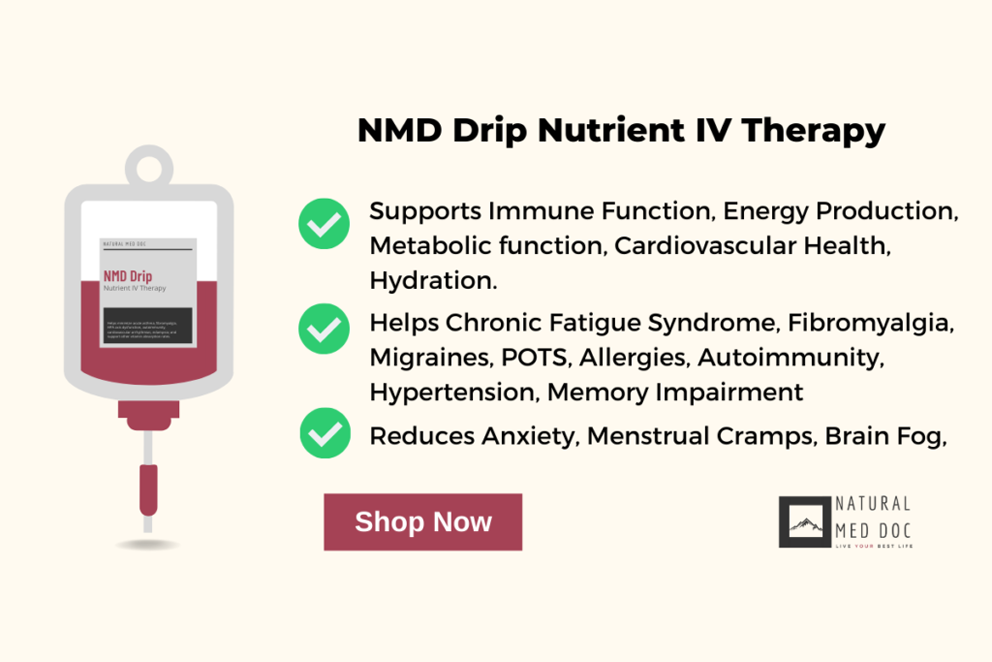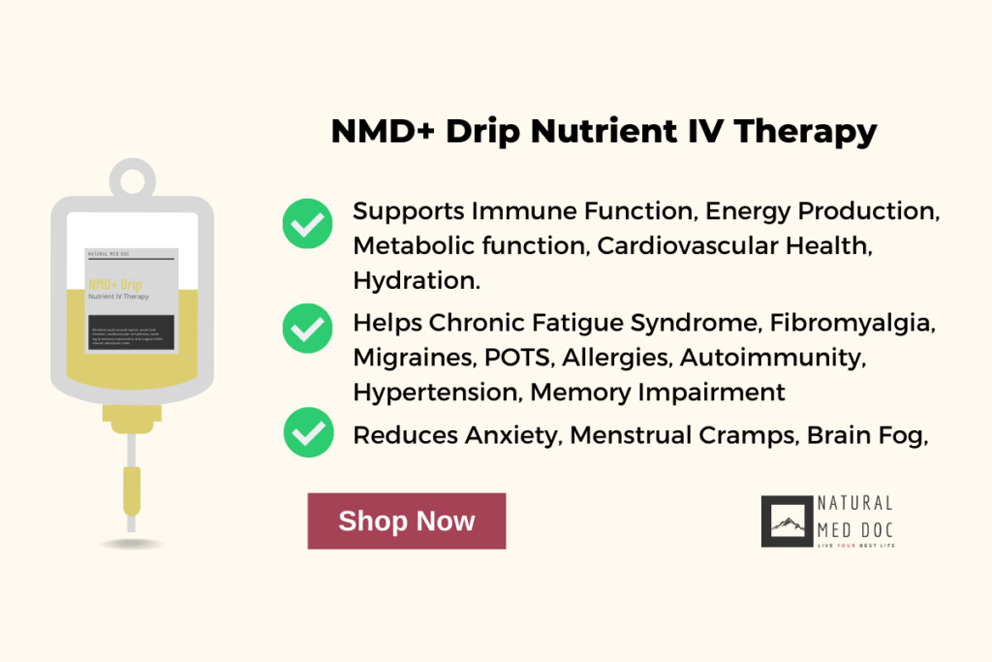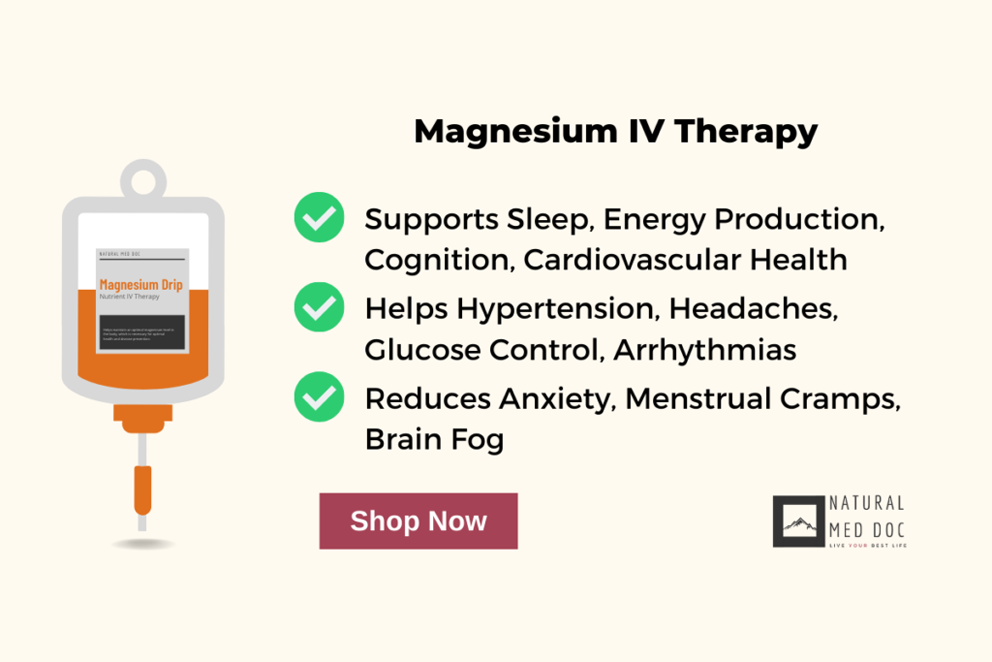By Dr. Sarah Bennett, NMD / February 16, 2022

Nutrient IV therapy, aka nutritional IV therapy or vitamin IV therapy, is the administration of vitamins, amino acids, minerals, electrolytes, etc., directly into the bloodstream. Intravenous administration is a faster, more direct, and more effective way to dose vitamins and nutrients.
Other routes of administration such as taking vitamins orally are limited by many factors including time to absorption, suboptimal absorption rates due to digestive dysfunction, detoxification processed limiting dose available to the rest of the body, and often poor bioavailability of active ingredients found in common supplement brands. Nutrient IV therapy surpasses these limitations delivering the desired micronutrients directly to the bloodstream for optimal results.
Nutrient IV therapy is often utilized to treat various diseases, conditions, and symptoms. Some of the top benefits of nutrient IV therapy include improving energy, immune function, exercise recovery, and sleep.
The use of modern infusion therapy began in 1902, with the administration of standard saline solutions. Nutrient IV therapy, however, was developed in the 1960s by Dr. John Myers, an internist from John Hopkins hospital in Baltimore.
Dr. Myers’ created the Myers formula, an infusion formula consisting of a combination of essential micronutrients including magnesium, calcium, B vitamins, and vitamin C. This formulation has been found to benefit acute asthma, fatigue, migraines, chronic fatigue syndrome, fibromyalgia, acute muscle spasm, upper respiratory tract infections, chronic sinusitis, seasonal allergic rhinitis, cardiovascular disease, and more! (1)
Nutrient IV therapy has been shown to provide a wide variety of health benefits, including but not limited to:
Myers’ Cocktail infusion, also known as a multivitamin infusion, commonly contains between 8-16 vitamins depending on the formula, which may vary based on clinic and provider preference. The Myers’ Cocktail formula may include a combination of magnesium, calcium, B vitamins, vitamin C, potassium, zinc, selenium, and taurine.
The direct intravenous administration of these vitamins and minerals allows the body to utilize the dose more quickly and efficiently, skipping absorption barriers and detoxifying organs.
Due to the high number of vitamins and minerals in Myer’s cocktail infusions, the benefits and indications for therapy are vast. These benefits and indications are listed as seen below:
These are the Natural Med Doc version of Myers’ Cocktail below!




Glutathione is the master antioxidant of the body, a tripeptide made up of cysteine, glycine, and glutamic acid. In addition to providing significant antioxidant effects, glutathione is involved in the phases of detoxification, mitochondrial function and energy production, cell cycle regulation, inflammation reduction, immune modulation, neuroprotection, anti-aging properties, and so much more. (14,15,16)
Studies suggest that glutathione is poorly absorbed via oral dosing, whereas administration via intravenous, inhalation and intranasal routes has improved systemic glutathione levels. (14,17)
Low glutathione levels have been associated with obesity, estrogen dominance, hypercortisolism, vitamin D deficiency, diabetes, hypertension, and certain pharmaceutical use, such as acetaminophen, antidepressants, and opiates. (18)
Glutathione inhalations and infusions have been specifically utilized to address the following symptoms and conditions:

Magnesium is an essential mineral found at high levels in the human body. This mineral is utilized in over 300 different biochemical processes and therefore is critical for optimal functioning of the body.
Although conventional providers rarely test serum magnesium levels, it has been found that 48% of Americans ingest less magnesium from food and beverage than the estimated average daily requirements for healthy individuals in the same stage of life. In addition, studies show that up to 20% of the population of developed countries (such as the United States) have an overt magnesium deficiency.
Magnesium deficiency may cause a variety of signs and symptoms, including low energy, brain fog, muscle spasms, aches, low appetite, nausea, vomiting, weakness, numbness, tingling, seizures, arrhythmias, personality changes, even low calcium levels. (24)
Magnesium infusions are commonly utilized to address the following symptoms and conditions:
Nicotinamide adenine dinucleotide (NAD+) infusions have emerged as a new cutting-edge anti-aging therapy.
NAD+ is an essential coenzyme found in all living cells, necessary for proper metabolism, energy (ATP) production, DNA repair, and more.
Many factors deplete NAD+ levels in the body, including extensive free radical-induced DNA damage, chronic inflammation and immune activation, aging-related increase in consumption, and decrease in synthesis.
NAD+ is often replenished utilizing intravenous administration.
NAD+ infusions have been shown to provide many health benefits, including decreased age-related degeneration and associated complications. These health benefits are listed below:
Nutrient IVs are generally considered to be safe and display and low side effect profile, but as with any therapy, there are possible side effects of adverse reactions.
A vasovagal reaction is basically when the body plays possum, causing a sudden drop in blood pressure heart rate, frequently causing a loss of consciousness. This reaction is most often caused by visualizing blood or using needles.
Infiltration occurs when the needle punctures through both sides of the vein, allowing the IV solution to begin and accumulate in the tissue outside the vein. This can cause a burning sensation that can be uncomfortable or painful. Infiltration is caused during placement of the IV if the needle punctures both sides of the IV, after an IV recipient moves, causing the needle to puncture through the other side of the vein, or if the vein collapses during the administration process. This is often a mild concern causing discomfort. The infusion needs to be placed in a different location. Placing a heating pad over the infiltrated site can alleviate discomfort and tenderness.
Puncturing the skin in any way (infusion, injection, injury) increases infection risk. Due to this increased risk, the mixing of IVs is regulated. Clinics are required to mix nutrient IVs in a hood or small cleanroom to ensure sterility of the product administered. Be sure to ask your provider about their infusion sterility and safety procedures prior to receiving an infusion.
Allergic reactions are a common possibility seen in response to many different treatments, Nutrient IVs included. Most allergic reactions are mild, needing only to remove the infusion. However, a more moderate reaction may require diphenhydramine to eliminate symptoms.
An Anaphylactic reaction is a life-threatening allergic reaction. Although this type of reaction is uncommon, it is a possibility. This type of reaction is treated with the administration of Epinephrine. All clinics administering Nutrient infusions should hold Epinephrine on hand at all times. Be sure to ask your provider if they carry Epinephrine prior to receiving your infusion.
Nutrient IV therapy has become an increasingly popular natural treatment option for a vast array of symptoms and disorders, ranging in use from immune support to the “hangover cure.”
Nutrient infusions allow fast direct dosing of micronutrients into the bloodstream allowing for higher bioavailability and treatment efficacy. In addition, these infusions are considered safe, holding a low side effect profile.
Most Nutrient IVs can be administered in 30 min to 90 minutes depending on size and drip rate, making the procedure fast and easy.
If you struggle with any of the symptoms or conditions listed above, be sure to ask your naturopathic physician about nutrient IV therapy.
References
Other references for further reading:
Hello, my name is Dr. Sarah Bennett, NMD!
I am a naturopathic physician licensed in the state of Arizona currently practicing at my office in Scottsdale, AZ. I received my degree from Southwest College of Naturopathic Medicine, did a year residency at Keystone Natural Family medicine, and received additional training for aesthetics & anti-aging at National Laser Institute.
My passion and fascination for natural medicine began during my undergraduate studies at Indiana University where I got a dual degree in neuroscience & psychology.
I saw how a preventative approach could help you live a long and youthful life. Since then I have dedicated my life to serving others to understand the latest medical trends.
I spend my spare time running, hiking, rock climbing, camping, testing out new diets, and reading books on latest medical trends / listening to podcasts to find the latest nuggets of knowledge to improve the quality of life for my patients. I look forward to serving you!